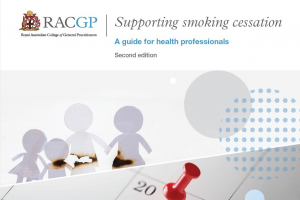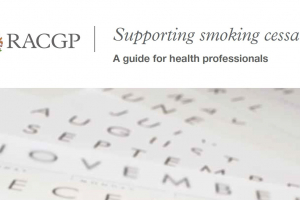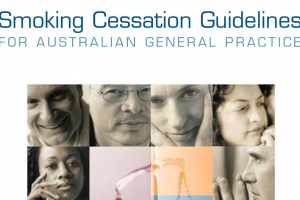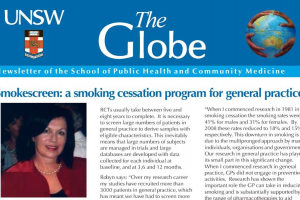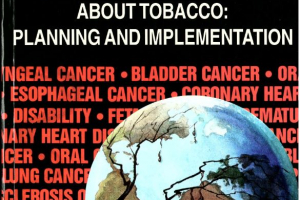Research and Training in General Practice in smoking cessation
When Robyn Richmond initiated tobacco research in general practitioners in 1981, 41% of males and 31% of females were smokers. At this time, around 44,000 Australians died annually from coronary heart disease, representing 40% of all deaths. Since then, there has been a significant decrease in smoking rates to 17% of males and 12% of females, and coronary heart disease now claims the lives of 18,590 Australians representing 12% of all deaths. The impact of government initiatives, as well as non-government organisations and individual doctors, alongside Robyn's activities in research, teaching and training, is evidenced in the significant reduction in the number of smokers in Australia over time.
In the 1980s, the smoking cessation interventions developed for use by GPs were based on the assumption that most GPs were prepared to engage in preventive activities and that all patients, if approached, would be prepared to stop smoking. Robyn Richmond's research at that time showed that only a small proportion of GPs were ready to engage in preventive activities with their patients, and few patients responded to the "one size fits all" approach to quitting. However, her research also demonstrated that the GP could be effective in assisting smoking patients who were ready to quit.
Robyn Richmond was the first in Australia and second in the world to develop multicomponent smoking cessation interventions for GPs to use, and to conduct research on their effectiveness in randomised controlled trials. The series of smoking cessation interventions that she developed, called the Smokescreen Program, acknowledged that the smoker’s own motivation to quit is a key factor in success and that advice provided by the GP should be based on the smoker’s readiness to quit. The Smokescreen Program was the first to apply the ‘stage of readiness to change model' in the general practice setting.
The Smokescreen program is evidence based and over 38 years has continued to be evaluated, revised and developed in response to hers' and others' research. Most recently, Robyn Richmond has evaluated the use of a smoking cessation mobile phone app for smokers with depression in general practice.
Over her career and continuing, she has conducted studies in general practice involving around 20,000 participants, including general practitioners, practice nurses and general practice patients.
Her research in general practice has been translated into policy, guidelines, training programs, and resources for use by the community.
Robyn Richmond has worked with communities since the 1980s and advocated for greater awareness of ways to improve healthy lifestyles. She has developed a range of tobacco resources that have been distributed into communities, working in joint partnerships in translations for people from non-English speaking backgrounds. This translation of research focusing on improving the health of communities demonstrates a sustained practice of providing evidence based resources to promote better health in different Australian and international communities and empowers individuals to address health issues within their own communities.
In 2002 the Royal College of General Practitioners invited Robyn Richmond to join the expert panel led by Professor Nicholas Zwar to develop smoking cessation guidelines for general practitioners in Australia. Her Smokescreen program was incorporated into the guidelines as the smoking cessation approach in general practice and it became a national smoking cessation program endorsed by the Royal College of General Practitioners and the Commonwealth Department of Health. In 2004, the Commonwealth Department of Health produced and distributed the guidelines for best clinical practice in smoking cessation to all 23,000 GPs across Australia.
The significance of the Smokescreen program becoming the basis of the tobacco treatment in the Australian guidelines for GPs and other health professionals is that it had evolved from an individual program developed at the University of New South Wales and became the national, evidence-based approach for doctors to use to assist patients to quit. This body of translational research work, in association with key organisations such as the Royal College of General Practitioners as well as the Commonwealth Department of Health, has led to major changes in medicine in which GPs now engage in prevention as part of their daily medical practice, including assisting smoking patients to quit smoking. The guidelines continue to be revised and updated on a regular basis, with a major second edition released in 2020.
Over two decades Robyn Richmond developed training programs for GPs and trained over 11,000 GPs and other health professionals in workshops across Australia. Additionally, she trained 800 general practitioners in New Zealand, and medical practitioners in China, Turkey, France, Iran, Malaysia and Japan on smoking cessation techniques and they have, in turn, then implemented training programs for doctors in their own countries.
Robyn Richmond’s work demonstrated the importance of general practitioners in reducing smoking, and triggered her commitment to introduce smoking cessation education into medical schools’ curricula. Her view is that providing teaching about tobacco control in medical schools ensures that future doctors are adequately trained to encourage their patients to quit smoking. She initiated and implemented the teaching of preventive strategies for medical students at UNSW.
Robyn Richmond has carried out a series of global studies over 20 years among medical students determined to ascertain the extent of teaching about tobacco and related diseases, and smoking cessation techniques in medical schools around the world. She identified serious deficiencies in education on tobacco in medical schools across the globe. She has conducted 4 surveys of medical schools, with the most recent ongoing, and has translated and implemented her tobacco curriculum into medical schools around the world, including in Germany, Turkey, China, Thailand, France, Cambodia, Iran, Laos, the Arab Gulf States, Italy, Romania, Japan and in Spain. Please see here for more information.
Robyn Richmond's research studies in General Practice
- Evaluation of general practitioners’ use of a smoking cessation intervention program: This study involved the development of a comprehensive multicomponent smoking cessation intervention for GPs to use with smoking patients, including training of GPs. It was the first research in Australia and the second in the world to evaluate the effectiveness of GPs providing brief advice to stop smoking and was the first in Australia to show that GPs can successfully encourage patients to quit and to show the importance of regular follow-up visits in maintaining abstinence. This work also showed that smokers who reduce cigarette consumption tend to maintain tobacco exposure by increasing inhalation and thus cessation, rather than reduction, should be the goal.
- Three year study of a smoking cessation intervention delivered by general practitioners to assist smokers to quit. This was the first study to follow up general practice patients to 3 years. It also identified predictors of successful smoking cessation and highlighted the importance of follow up visits and individual advice for the patient.
- Dissemination and uptake of a smoking intervention in general practice. This study showed that GPs were much more likely to continue using a smoking cessation interventions with their patients if they received reinforcement contact and support.
- One year evaluation of three smoking cessation interventions with nicotine gum administered by general practitioners. This was the first published study comparing different smoking cessation interventions for GPs to use with smoking patients. This study confirmed the importance of a structured behaviour change intervention when used in combination with anti-smoking pharmacotherapy and was the first to combine evidence based smoking cessation components into an intervention for use in general practice.
- Heavy smokers, drinkers and overweight patients attending a general practitioner. GP patients in this study reported that they thought GPs should be interested in their lifestyle behaviours, particularly smoking, but that GPs tended to give lifestyle modification advice only when unhealthy lifestyle habits were significant and causing health issues.
- Utilisation of a smoking cessation program among general practitioners in NSW. This research found that GP’s intervention with smoking patients resulted in a significant reduction of smoking. The importance of the GP in smoking cessation was adopted as a recommendation in the treatment outline for smoking cessation.
- Review of research in general practice for smokers and excessive drinkers in Australia and the UK. This research particularly identified the need to motivate GPs to intervene with their smoking patients, and the importance of matching patients to interventions according to their readiness to change.
- Short-term effectiveness of bupropion hydrochloride sustained release for assisting smoking cessation in general practice. This was the first study of bupropion in Australian general practice and found encouraging short-term abstinence rates but that many patients did not adhere to the prescribed course of bupropion or make use of cessation support services.
- Review of bupropion for smoking cessation. This review highlighted the accumulation of evidence for the effectiveness of bupropion in smoking cessation, and the importance of GPs’ awareness of contraindications.
- Research and development of best practice guidelines on smoking cessation for Australian general practice. The first smoking cessation guidelines for Australian general practice were developed by a national group of experts formed on the invitation of the Commonwealth Department of Health. The treatment for smokers recommended in the guidelines was based on Robyn Richmond’s Smokescreen GP Program.
- Evaluation of the best practice guidelines in smoking cessation for Australian general practice. The evaluation of the guidelines identified a high rate of continuing use of the guidelines and an increase in GPs’ confidence as a result of the training.
- General practice patients’ readiness to quit smoking. Prior to this work, no study had been conducted in Australia among GP patients to ascertain their stage of readiness to quit smoking. The prevalence of smokers among GP patients was found to be higher than in the community indicating that smokers attend their GP more frequently. One fifth of GP patients were ready to quit smoking and many others were willing to discuss their smoking with their doctor. GPs should focus their attention on those ready to make a quit attempt.
- Worldwide study of the training of medical practitioners in smoking cessation. A global survey on postgraduate education on tobacco identified the need for new approaches to expand availability and uptake of education on smoking cessation among doctors.
- Development and evaluation of a primary care smoking cessation service for the practice nurse. This was the first study to explore the effectiveness of a practice nurse (PN) intervention to support smoking cessation in Australia general practice. The expanded role of the PN showed promise as a means of providing cessation support.
- Quit in general practice: a cluster randomised trial of enhanced in-practice support for smoking cessation. This study evaluated the effectiveness of PN delivered smoking cessation to smokers. Those who attended all four PN visits were more like to quit.
- Depression and smoking among patients attending a general practitioner. Smoking patients with depression were followed up by telephone interview to explore the best ways to assist them to quit smoking. They reported using smoking as a form of self harm, and a strong desire for face-to-face support during the quitting process. Smoking and depression were found to be strongly interconnected, and feelings of hopelessness and low self-esteem were exacerbated by failed quit attempts.
- Practice nurse intervention for depression and smoking among patients attending a general practitioner. This demonstration study assessed the effectiveness of a smoking cessation app with PN support in reducing smoking and improving depression in people living in rural New South Wales.
Research and Training in General Practice in reducing risky alcohol consumption
Robyn has translated her understanding and practical experience gained from conducting studies among smokers to the study of treatments for people who drink alcohol at risky levels. This has involved applying the research methods and interventions developed in her studies among smokers to the study of unsafe alcohol use. She has applied these research technologies to some of the same populations that were the focus for her smoking studies.
Risky alcohol consumption is a significant public health problem among 3.7 million Australians. When Robyn Richmond commenced research in this area in 1985, there were, among drinkers of alcohol, 37% of males and 26% of females who consumed alcohol at hazardous or harmful levels at least one day a week. The NHMRC guidelines for these levels of consumption were at the time of the studies, more than 4 drinks for men and more than 2 drinks for women.
- Alcoholscreen: controlled evaluation of a general practice based brief intervention for excessive drinkers. This study was the first in Australia and among the first in the world to evaluate the effectiveness of the GP in reducing alcohol consumption among patients. It was the first in Australia to take a harm minimisation approach focusing on the specific harms caused by risky alcohol use including personal, family, social, legal and health which result in morbidity and mortality. It was an important seminal study grounding brief intervention for people with risky alcohol consumption.
- Implementation and dissemination of a controlled drinking program in general practice. This study found that training conducted in GPs’ surgeries achieved greater GP utilisation of a brief intervention to reduce excessive drinking among patients (called the Drinking Detective Program) and further confirmed that brief interventions from GPs benefitted patients who were drinking alcohol excessively.
- Heavy smokers, drinkers and overweight patients attending a general practitioner exposed the tendency of GPs to give lifestyle behavioural advice only when unhealthy lifestyle habits were significant and causing other health issues.
- Early detection and reduction of alcohol misuse in general practice. This study was the first to evaluate and successfully demonstrate the feasibility of using hand-held computers to detect alcohol misuse among GP patients before health issues were identified.
Research in the workplace to reduce tobacco use and risky alcohol consumption
In the course of her general practice research, Robyn Richmond identified that there were very few young males from blue collar backgrounds who visit a GP and thus identified the workplace as a key location to access this population. She was the first to report on the unhealthy lifestyle behaviours of Australian blue collar workers. From a public health perspective, the blue collar workplace has the advantage of reaching a large proportion of the community who are under-represented in general practice.
Tobacco use among employees is costly in terms of health, social and financial costs to community and industry. When Robyn Richmond commenced research in this area in 1991, smoking rates for blue collar workers were 51% among men and 36% among women, and were 26% and 23% respectively among white collar workers.
- Policies and programs in the workplace: survey on programs for smokers and people drinking in a harmful way. The monograph resulting from this study, Workplace Policies and Programs for Tobacco, Alcohol and Other Drugs in Australia was the first to survey tobacco and alcohol use in industry in Australia.
- Australia Post. This is one of the original studies to report on the health habits of Australian blue collar workers including their views of the employer as a lifestyle intervention provider. It found high rates of unhealthy lifestyle factors such as smoking, excessive alcohol use and inactivity. It highlighted the significance of the blue collar workplace as an important opportunity to reach large numbers of the community who are less likely to visit their GP, and who may be unaware that their lifestyle habits pose a health risk.
- NSW Police Service. A data analysis found that lung cancer deaths were more common among police, alcoholic liver disease deaths among police were twice that of the general population, and that excessive drinkers had significantly more sick leave days off work. A range of interventions was developed for use in the workplace including resources to reduce tobacco use, modify risky alcohol use, improve physical inactivity and poor nutrition.
- Comparing treatment outcomes between a workplace and a hospital smoking cessation program. This was the first study comparing smoking cessation interventions delivered in the workplace with those in a hospital smokers’ clinic. Compared to worksite participants, outpatient participants were older, smoked more, were more dependent on nicotine, had more social contact with smokers, expected it to be more difficult to stop, and rated their chances of success lower, but had made more quit attempts and were more motivated to quit.
- Stage distributions for five health behaviours in two countries. A collaboration with US colleagues examined stages of readiness to change five health behaviours: smoking, low fat diet, regular exercise, reducing stress and losing weight. The resulting meta-analysis extended stage distribution information from smoking to four additional risk factors.
Studies in other community settings, hospitals and treatment agencies
- Screening for excessive drinkers in four Sydney teaching hospitals. General hospitals provide an ideal setting to detect and intervene with risky drinkers. Yet health professionals have been reluctant to ask about excessive alcohol use. This was the first study based on motivational interviewing to change behaviour. The practice of motivational interviewing became a global phenomenon with many researchers around the world using motivational interviewing in their behaviour change studies.
- Effects of brief counselling among male heavy drinkers identified on general hospital wards. This was the first controlled study in Australia to find that counselling male heavy drinkers on hospital wards resulted in a significantly greater reduction in weekly alcohol consumption at six months follow up compared to a control group.
- The use of brief interventions for controlled drinking in Australian alcohol treatment agencies. A survey of 179 drug and alcohol treatment agencies in Australia to determine the extent to which they offered brief advice and treatment aimed at moderation of alcohol consumption, in alignment with the National Health Policy on Alcohol in Australia (1990). Controlled drinking as a treatment goal was widely offered by a substantial proportion of Australian treatment agencies.
- Alcohol services provided in treatment agencies for Indigenous people in Australia. From 29 (of the 179 above) treatment agencies that provided services primarily for Indigenous people, only half offered approaches including brief interventions with goals of moderation, while the other half were abstinence oriented. This research work laid the foundation for policy development in this area to encourage harm minimisation approaches.
- Online alcohol sales. Current research: Understanding the online alcohol delivery market in Australia to inform improved regulation of the industry and reduce alcohol-related harm will contribute to reducing the negative health and social impacts of alcohol consumption in Australia. This research is the first to investigate the targeted marking of the online alcohol delivery market in Australia and the marketing experience and exposure of consumers.
- Research among pregnant women to reduce smoking. Current research: Even after years of extensive public health smoking cessation programs, 9% of Australian mothers still smoke in pregnancy. This average marks a starker reality with rates of smoking across Australia varying by geography, poverty and ethnicity. Smoking rates among some populations are as high as 40% compared to 2% among other populations. Smoking in pregnancy is an established cause of poor pregnancy outcomes including increased risk of stillbirth, preterm delivery, low birth weight and fetal abnormalities. Its effects persist into infancy and childhood and have been associated with sudden infant death syndrome and childhood conditions such as asthma, attention deficit disorder and obesity. This research aims to integrate technology such as a smoking cessation app, expired carbon monoxide measurements and text messaging with individual support from a specialised antenatal midwife to reduce smoking rates among pregnant women.


